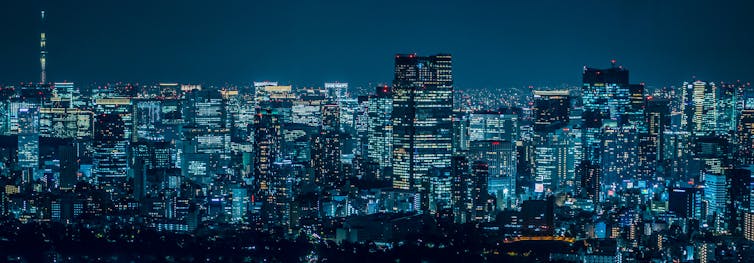 petroleum man/Shutterstock
petroleum man/ShutterstockJapan has a very clear vision of what the Asia-Pacific’s clean energy future looks like – decarbonisation, but done slowly and with a longer role for coal, oil and gas.
It was on full display this week as energy ministers from nine South-East Asian nations, Japan and Australia gathered in Jakarta to hash out a shared vision for Asia’s energy future, under Japan’s Asian Zero Emissions Community (AZEC) initiative launched last year.
But there’s a clear problem here. Japan’s vision clashes directly with Australia’s efforts to become a green export superpower. And worse, Japanese investment is a key reason why Australia has emerged as an unlikely gas export giant.
Energy security is front of mind for Japanese policymakers worried about keeping the lights on across their import-dependent archipelago. While Tokyo does have green energy plans, its short-term push is all about prolonging the life of fossil fuels – coupled with carbon capture.
Labor came to power promising to act faster on climate change. By decade’s end, Australia should be largely run on renewables, and Canberra wants to make clean exports a reality.
But Japan is making that harder by financing gas exploitation in Australia. This could lock our fast-growing and energy-hungry region into much longer reliance on dirty fossil fuels and questionable carbon capture plans.
There’s a real danger Australia’s green export plans could be washed away by a tide of new fossil fuels.
So what are Japan’s zero emission plans?
In 2022, the Japanese Prime Minister Kishido Fumio began promoting a triple breakthrough – efforts combining decarbonisation, economic growth and energy security. Fumio launched the Asian Zero Emissions Community to encourage the idea.
While these goals sound reasonable, the devil is in the detail. The world’s fourth-largest economy, Japan has long been dependent on imported coal, oil and gas – and more so after the 2011 Fukushima disaster forced nuclear plant shutdowns. Even as the world belatedly scrambles to tackle climate change, Japanese policymakers are still focused on keeping fossil fuels flowing. Many AZEC projects aim to use fossil fuels for electricity.
The government’s energy policies explicitly aim to secure long-term supplies of fossil fuels and encourage Japanese firms to be involved. Japan is now the world’s second-largest public financier of international fossil fuel projects, spending more than A$7 billion every year.
How does this align with net zero? Japan claims new fossil fuel plants can slash emissions by burning ammonia in coal plants, blending hydrogen with fossil gas in gas plants and ramping up carbon capture and storage.
Each of these technologies is expensive and largely unproven. They cannot cut emissions at anywhere near the scale or speed needed. And every million spent on propping up fossil fuels is a million not spent on renewables and storage.
 As Indonesia and other South East Asian nations grow, they need more energy. Will it come from fossil fuels or renewables?
Saelanlerez/Shutterstock
As Indonesia and other South East Asian nations grow, they need more energy. Will it come from fossil fuels or renewables?
Saelanlerez/Shutterstock
Japanese funding makes Australian gas flow
Japan sees Australia as a friendly nation with huge fossil fuel resources and longstanding trade links.
Any changes to coal and gas extraction have been met with Japanese lobbying. When Queensland hiked coal royalties in 2022, Japan’s ambassador to Australia, Shingo Yamagami, pushed back hard. The move, he warned, could have “widespread effects on Japanese investment beyond the coal industry”.
When the federal government strengthened the Safeguard Mechanism, our main industrial emissions policy, costs increased for some gas projects. In response, Yamagami dialed up his rhetoric, warning the neon lights of Tokyo would go out without Australian energy exports.
 Would the lights of Tokyo go out without Australian gas?
takuya kanzaki/Shutterstock
Would the lights of Tokyo go out without Australian gas?
takuya kanzaki/Shutterstock
Japan isn’t burning it all at home. It on-sells more liquefied natural gas (LNG) to other Asian nations than it imports from Australia. Without Japan’s funding on favourable terms, our LNG producers would not be able to compete with lower-cost producers such as Qatar.
Given a global gas glut is now forecast to arrive by 2026, Australia should be looking to dial down LNG. But Japan won’t let that happen.
Just this year, Japan loaned $2.5 billion to help Woodside develop Western Australia’s massive Scarborough gas field.
Independent and green – or dependent and dirty?
Domestically, Australia is greening. Coal is retiring as renewables and storage rush in. Last year, 40% of the power in our main grid came from clean energy and more than 80% of Australia’s total power needs should be provided by renewables by 2030. But internationally, we’re now the second-largest exporter of carbon emissions from fossil fuels.
With major reserves of critical minerals (essential for renewables and batteries) and world class renewable resources, Australia is ideally placed to export green commodities to the region.
The Albanese government is promoting Australia as a “renewable energy superpower” and will invest public money through the Future Made in Australia plan to give local green industries a chance of global success.
But Japan has a different vision. Funding flows from Tokyo have already distorted Australia’s energy market and boosted demand for gas in the region. Worse, it has made it harder for Australian leaders to create future-focused industries. New gas projects pull investment, workers and supply-chain capacity away from clean energy industries.
It’s not that Japan is anti-renewable. It’s just slow to move. Tokyo has ambitious plans to become the world’s top producer of energy from offshore wind.
Recent modelling shows Japan could achieve 90% clean energy by 2035, gaining far greater energy independence and slashing reliance on expensive fossil fuels. If Japan took this route, we would likely see its Australian investments shift from gas to green exports.
But right now, Japan’s focus is on keeping fossil fuels flowing.
Australia has to help shape Asia’s energy transition. If we don’t, we risk our future being made in Tokyo.
Wesley Morgan is a research fellow with the Griffith Asia Institute and a fellow with the Climate Council of Australia.

 3 months ago
59
3 months ago
59


